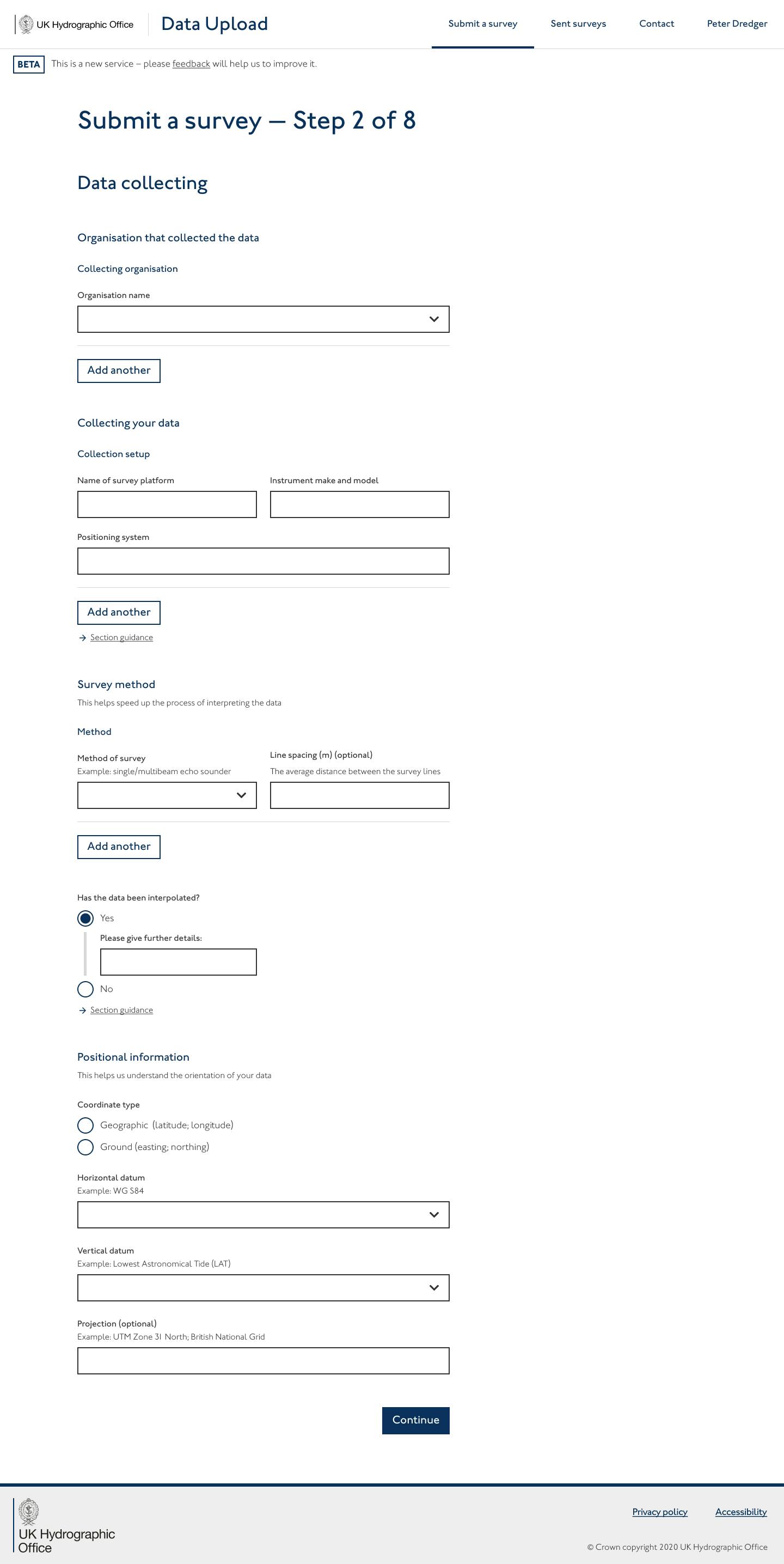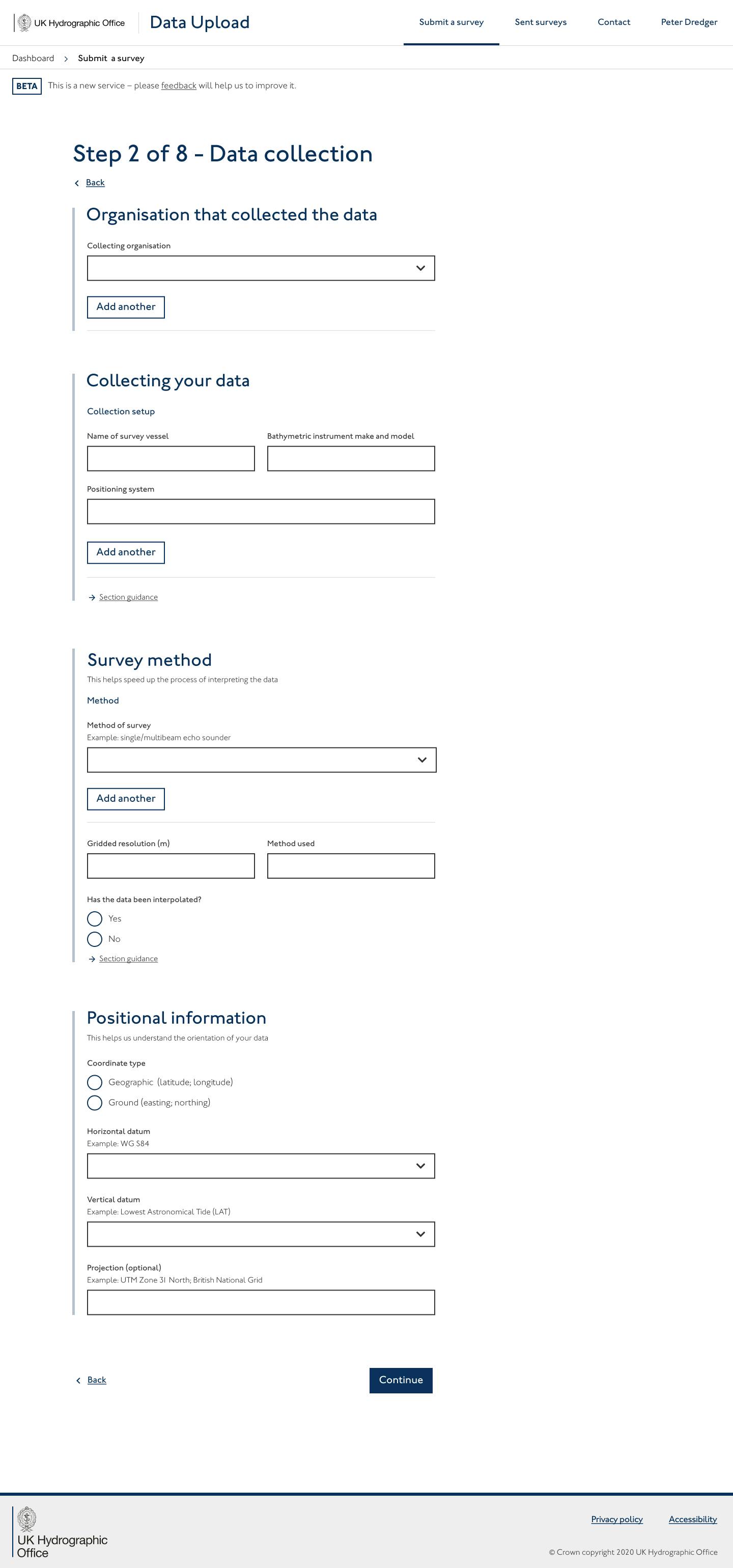Image of research notes and affinity map

An overview of the roles and activities of a User Experience Designer in delivering a service for uploading bathymetry survey data via a digital form.
Discovery revealed that, as a leading global data aggregator, the UK Hydrographic Office (UKHO) needed to enable data providers to deliver high-quality data efficiently. A ‘Happy Path’ proof of concept emerged from an ‘Alpha’ discovery phase.
Our task was to test and refine this proof of concept with users to define the Minimum Viable Product.
We were advised to adhere to the UKHO design system and took inspiration from .GOV best practices and WCAG accessibility guidelines. Our team adopted an agile approach, aiming for the gold standard in user-centred design, an approach which hadn't been well adopted in the past at UKHO.
The UX team comprised three members: a User Researcher, a Content Designer, and myself. Together, we handled all aspects of the service from a UX perspective, addressing both internal and external needs. The wider team included UI Developers, Backend Developers, Test Engineers, Delivery Manager, Product Owner and a Change Delivery Manager.
Guided by our synthesis of user research we created insights, user journeys and sparked discussions about user needs, goals, and behaviours. From there, we are able to focus around the user problems.
We identified these main insights and opportunities:
1) Guidance
The large guidance document was overwhelming and had too much information.
How might we make guidance more accessible and easier to navigate, so users can quickly find the information they need without feeling overwhelmed?
2) Copy a Survey
Users often uploaded the same data with slight amendments – they needed to copy previously created surveys to make the process quicker.
How might we enable users to easily duplicate and amend previous surveys to streamline repetitive tasks?
3) Highlight a Survey of Importance
Users often needed quick access to surveys they used regularly.
How might we help users quickly locate and access their most important or frequently used survey
Image of research notes and affinity map

Working in sprints we collaboratively designed tested and refined solutions to meet the needs of our users. This included:
Guidance: we created an 'in context guidance' component which enabled us to remove an unnecessary page of content. You can view the component here.
Copy a survey: Ideation and testing enabled us to refine a user flow to 'duplicate a survey'
Highlight a survey of importance: Team collaboration, ideation and usability testing enabled us to create function to 'pin a survey'.
There was also an opportunity to refine the page designs which over the course of the project had lost its cohesiveness and integrity.
As a team we communicated regularly via refinement, 3 amigos to ensure that designs were implemented as expected. In a fast-paced project like this I found it useful to use a UX tracker and versioning system to record why which insights informed each iteration and why/when changes were made. I also found it useful at the of each epic to organise a multidisciplinary heuristic evaluation.


The service increased the both the quality and volume of data received via ports. Because more data is being received, it has increased a number of workflows, improving survey data and making port areas in the UK safer for mariners.
Creating a product that aligned with user needs and increased our confidence in the public beta launch. The user centred design approach strengthened stakeholder relationships, contributed to enhancements in the design system, and promoted collaborative learning and design improving team morale.
“Its a better process, quicker” - User feedback
“Only took my 2 minutes to complete” - User feedback
“Pretty methodical from start to finish, its logical” - User feedback
The UX contributions to this product were recognised, leading to an award from the Chief of Technology for our achievements. Additionally, our approach was highlighted in an external programme review, which recommended expanding this method of working across all projects within the organisation.
Culturally the delivery was really strong, very impressive. To time, scope and budget. - External programme review
Demonstrated agile best practise and user centricity, understood service standards, carried out user research and user centred design. - External programme review
Teams WoW absolutely highlighted best practise in how to deliver and should be expanded across all projects being worked on. - External programme review
This project helped solidify my understanding of the UX process in an agile delivery team, something I had longed for at UKHO. UX is new to UKHO, the team is small, we have to be creative to make sure we get a seat at the table. I truly enjoyed the whole experience, it taught me a great deal about the value and depth involved in creating a form, which are essentially the building blocks of the internet. It also highlighted the importance of Content Design, which I co-wrote a GOV Digital blog post on which can be viewed here.
Working with such a collaborative, progressive, and receptive team is a luxury at UKHO, given the complex internal ways of working. It was a pleasure to be part of a team that is paving the way for new and improved ways of working, with UX at the heart of that effort.